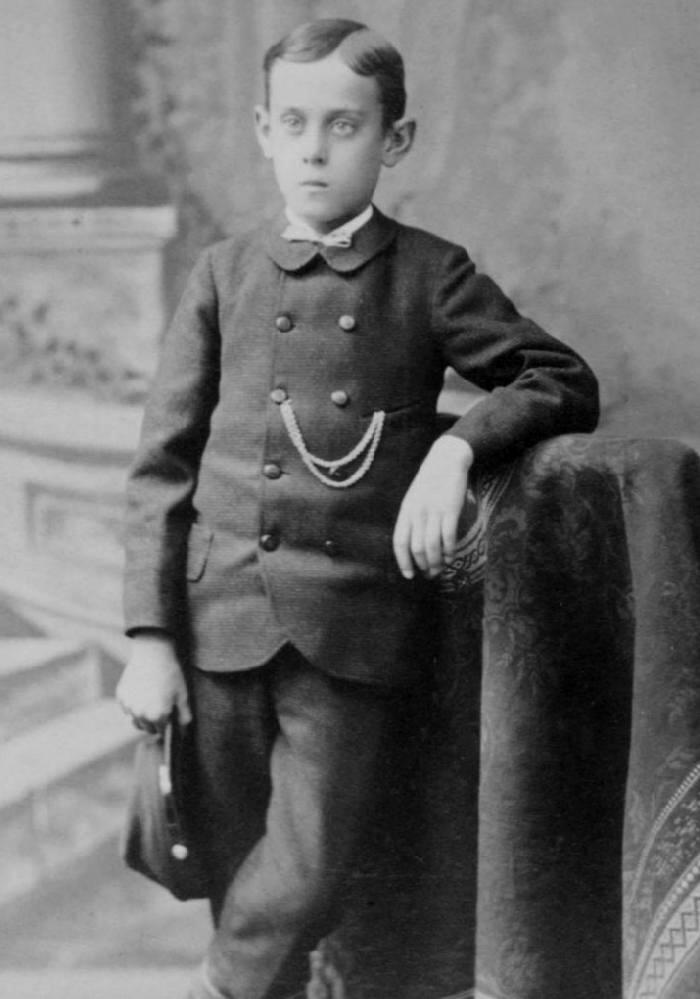
United States Suit Components: Headwear--Alternative Approaches

Figure 1.--This studio cabinet portrait of a boy shows a boy in a collar buttoning mock double-breasted knee pants suit. It klooks like his kepi cap matches the color of his suit which almost certainly was blue. The cap presumably was purchased separately from the suit. He has what appears to be a pocket watch (the chain is visible). The photographic studio was the Highland Gallery in Boston, Massachusettes.
|
|
Concerning headwear, there were three basic alternatives for what a boy wore with his suit. There were matching, coordinated, and non-matching headwear. These alternatives varied over time as well as with a boy's age and style of suit. The basic suit is a jacket or other top and matching pants. Three-piece suits, usually meaning added vests were very popular in the 19th century. Less common were suits with matching headwear. Headwear was very common in the 19th century and early-20th century. Usually the headwear worn was bought separately from a boy's suit and did not match it. But matching headwear did exist, usually for younger boys. Matching hats were unusual, but we do notice several styles of matching caps. These most common were sailor caps, but we notice flat caps and peaked caps as well as other styles.
Some boys' suits came with matching headwear. Most did not, but matching headwear was seen as stylish and mothers might purchase headwear seem as matching. This could include both hats and caps. Caps seem the most common. We haven't seen matching hats very commonly, but they could be matched in color if not in fabric. And of course sailot hats could be won with sailor suits. we have seen matcing caps in various styles. Caps could be matched with both the same material and color as the suit. We notice some 19th century suits for younger boys with matching caps of various styles. These might be done in matching colors. Tams seem to have been popular. We also see Glengaries, but there were many other styles. We notice some 19th century suits for younger boys with matching caps of various styles. Tams seem to have been popular. We also see Glengaries, but there were many other styles that were made to match boy's suits. We also see some done in the 20th century, but a more narrow range of styles. We also see matching caps in the 20th century. A matching peaked cap worn with an Eton or other styled suit was popular during the mid-20th century, here the flat or peaked camp was ofen used.
Coordinated Headwear
We see boys with coordinated headwear. This means headwear that while not necesarily matching was coordinated with the suit. Some coordinated headwear might also be in matching colors and or material, but here the basic idea was the theme. The most common were sailor and Scottisj outfits. Tghere were both sailor hats and caps to coordinate witj sailor suits. The sailor hats were often done in straw abd thus did not usually match tyhe suit. Caps were aifferent matter. Sailor caps often did match the suit, although this varied. There were two major Sciottish caps, glemgarys and balmorals. Tghey sometimes, but not always were done in matching colors and material. Zouave suits also sometimes had coordinated caps.
Boys wore both caps and hats with suits. We note a very wide variety of styles which of ciourse varied over time. Normally it was caps that were made to match suits. Hats were worn with suits, but they normally did not match in the sense of being the same color and material. Non-matching caps came in an even wider sortment of styles than matching caps. Most of the images we have found show boys with non-matching headwear More commonly we see caps and hats that were neither matched or coordinated with the suits. We note boys wearing a wide variety of caps and hats with suits. Until the 1960s, headwear was very common when dressing up. Today some of the 19th century choices seem rather inappropiate because modern conventions had not yet developed concerning some of the hreadwear types, specially the caps.
HBC

Navigate the Boys' Historical Clothing Web Site:
[Return to the Main U.S. suit headwear page]
[Return to the Main U.S. hat style page]
[Return to the Main U.S. country garment page]
[Introduction]
[Activities]
[Biographies]
[Chronology]
[Clothing styles]
[Countries]
[Bibliographies]
[Contributions]
[FAQs]
[Glossary]
[Images]
[Links]
[Registration]
[Tools]
[Boys' Clothing Home]
Created: 3:45 AM 7/3/2011
Last updated: 3:04 AM 4/19/2014



